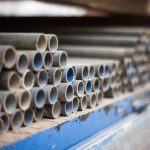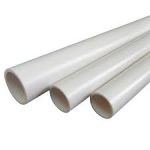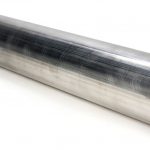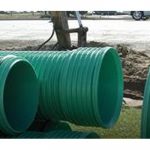C900 is an American Water Works Association (AWWA) standard PVC pressure pipe, for water transmission and distribution applications. It is equivalent to cast iron pipe for the same applications in terms of outside diameter. In this article, you will learn more about C900 pipe, review some specifications, and compare it to Schedule 40, as well as C905 pipe.

More on the C900 Pipe
C900 pipe offers a safe, long-lasting, and stable solution, so it is common in modern infrastructure. Although the pipe standard was initially developed for only potable water service, recent revisions include wastewater and reclaimed water systems. The benefits of deploying this pipe in an application include:
- It is immune to almost all types of internal and external corrosion because it is not a conductor. Thus, it offers a cheaper alternative to metal pipes as it does not require coating or cathodic protection. In addition, it is not susceptible to acid or alkaline soil conditions, which makes it effective in underground applications.
- The C900 maintains its smooth interior over several years of service, so there is hardly any frictional loss. Moreover, it possesses superior flow characteristics with a Hazen-Williams flow coefficient of 150. This puts less demand on pumping capacity, thus, offering savings in pumping costs and on pipe size requirements.
- Because the hydrostatic proof test of the C900 is up to four times its pressure class, it is able to offer long-term durability. The standard also ensures that the bell-gasketed joint meets the same strength requirement as the pipe. Combining this strength with the flexibility of PVC pipes, the joint and pipe assembly can bend without breaking to compensate for minor earth movements.
- It is easy to install and carry out repairs, as it can be field-cut using a power saw or handsaw and beveled, without the aid of expensive machinery.
Specifications
Since the initial development of the AWWA C900 in 1975, there have been several revisions of the standards with changes to aspects of the pipe.
Dimensions, Pressure Classes, and Applications
Although standard lay lengths remain at 20 ft +/- 1-inch, the pipe size range has expanded from 4 to 12 inches, to 4 to 60 inches. Thus, it encapsulates the C905 standard, which previously served for pipes greater than 12 inches. By extension, more dimension ratios (ratio of pipe outside diameter to minimum wall thickness) have been included as the table below shows.
| Pipe Size (in) | Dimension Ratio | Pressure Class (psi) |
| 4, 6, 8, and 12 | 27.5 25 21 18 17 14 | 150 165 200 235 250 305 |
| 14 and 16 | 41 32.5 27.5 25 21 18 17 14 | 100 125 150 165 200 235 250 305 |
| 18, 20, and 24 | 51 41 32.5 27.5 25 21 18 17 14 | 80 100 125 150 165 200 235 250 305 |
| 30 | 51 41 32.5 27.5 25 21 18 17 | 80 100 125 150 165 200 235 250 |
| 36 | 51 41 32.5 27.5 25 21 18 | 80 100 125 150 165 200 235 |
| 42 | 51 41 32.5 27.5 25 21 | 80 100 125 150 165 200 |
| 48, 54, and 60 | 51 41 32.5 27.5 25 | 80 100 125 150 165 |
In addition, the scope of the C900 now includes non-potable water applications in recent revisions.
C900 Pipe Testing
A major cause of C900 pipe failure stems from manufacturing defects. These defects include incomplete fusion of extrusion knit lines, incomplete resin fusion, and inhomogeneity of the filler content. Thus, testing is crucial to verify the quality of products. Some of these tests include:
- Sustained Pressure Test: This is a 1000-hour test for the qualification of the compound and extrusion process.
- Burst Pressure Test: Carried out at specific frequencies, this destructive test determines the absolute maximum pressure at which the pipe fails catastrophically, or begins to plastically deform when pressurized.
- Ring Tensile Test: This safer alternative to the burst pressure test involves cutting a piece of piece out and pulling it to test its ductility.
- Hydrostatic Pressure Test: This internal pressure test is a requirement for each piece of standard length.
- Fusion Joint Test: The method for qualifying fusion joints has become a popular field joint method in modern installations.
Pressure testing of the C900 depends on the dimension ratio of the pipe as the table below highlights.
| Dimension Ratio | Pressure Class (psi) | Sustained Pressure Test (psi) | Burst Pressure Test (psi) | Hydrostatic Pressure Test (psi) |
| 14 | 305 | 650 | 985 | 610 |
| 17 | 250 | 530 | 800 | 500 |
| 18 | 235 | 500 | 755 | 470 |
| 21 | 200 | 420 | 630 | 400 |
| 25 | 165 | 350 | 535 | 330 |
| 26 | 160 | 340 | 500 | 320 |
| 27.5 | 150 | 320 | 475 | 300 |
| 32.5 | 125 | 270 | 400 | 250 |
| 41 | 100 | 210 | 315 | 200 |
| 51 | 80 | 170 | 260 | 160 |
Safety Factor and Temperature Coefficients
Because of variations in manufacturing, materials, installation, and unforeseen factors, the C900 standard uses a safety factor of 2.0 to calculate pressure capacities. In addition, these capacities are adjusted by temperature coefficients, as all PVC pipes experience a decrease in strength with rising temperature.
| Temperature | Pressure Reducing Coefficient | |
| ℉ | °C | |
| 80 | 27 | 0.88 |
| 90 | 32 | 0.75 |
| 100 | 38 | 0.62 |
| 110 | 43 | 0.50 |
| 120 | 49 | 0.40 |
| 130 | 54 | 0.30 |
| 140 | 60 | 0.22 |
Schedule 40 vs C900 Pipe Standards
Both Schedule 40 and C900 are common options for water pipe systems, but they have basic differences as the following table highlights.
| Schedule 40 | C900 |
| Materials for making Schedule 40 include galvanized mild or low carbon steel, as well as PVC. | This standard only serves for PVC pipes. |
| Generally, are thin-walled pipes. | C900 has relatively thicker walls vs Schedule 40. |
| Ideal for low to medium-pressure installations where pipe sizes are 4 inches or less such as residential buildings. Due to its typically thinner walls and high avaialability, it is generally cheaper than C900. | Ideal for low to medium-pressure installations, but generally serves a much broader size range than PVC. |
| It is a glue joint pipe, so it provides a restrained system. However, becomes susceptible to leakages at joints over time. | It is a gasketed pipe, thus requires thrust restraints at bends, tees, etc. As a result, provides more robust connections than PVC, minimizing leakages. |
C905 vs C900 Pipe Standards
The C905 and C900 are both pipe standards from the AWWA, with the table below highlighting their differences.
| C905 | C900 |
| The first edition was published in 1988 to cover potable water pipes with nominal sizes between 12 and 48 inches. | The first C900 edition was published in 1975 covering potable water pipe sizes from 4 to 12 inches. |
| Earlier revisions have smaller safety factors because their design is for larger transmission lines with minimal surge pressure spikes. Also, hydrostatic pressure testing for individual pipes in earlier revisions was at a pressure two times its pressure class. | Generally, they have larger safety factors due to smaller pipes being more susceptible to surges in pressure. While individual pipes were hydrostatically tested at a pressure that is four times its pressure class. |
| The C905 is no longer published since the 2016 revision, as it has been absorbed into the C900-16. | Earlier revisions have smaller safety factors because their design is for larger transmission lines with minimal surge pressure spikes. Also, hydrostatic pressure testing for individual pipes in earlier revisions was at a pressure two times it pressure class. |



